Looking for an interesting invertebrate to add to your tank? Let’s take a look at the Feather duster worm, (also sometimes called a fan worm) to see if it’s a good fit.
Table of contents
If you are looking for something specific, you can use the Table of Contents below to jump right to that section.
Quick Facts About the Featherduster Worm:

- Scientific Name: Sabellidae sp.
- Common Species: Hawaiian, Dwarf, Royal, Yellow, Coco Feather duster worm
- Other common names: Feather duster or Fan worm
- Max Size: 2.5 Inches
- Minimum tank Size: 10 Gallons<span class=”Apple-converted-space”>
- Aggression Level: Docile
- Color: Varies By Species
- Care Level: Moderate
- Lifespan: 1 To 2 Years
- What do they eat?: Plankton filter feeder
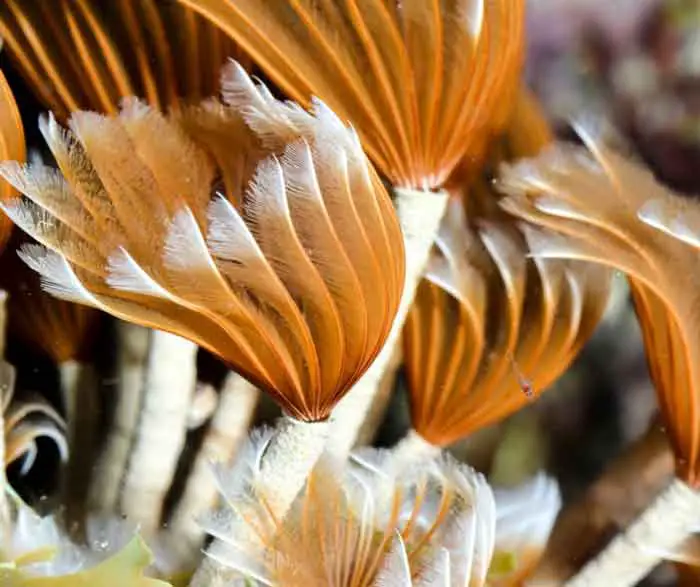
Natural habitat
A Featherduster worm is often found in the subtidal zones of reefs around the world, positioned in moderate currents where plankton meals get brought to them each day that are gentle enough to not damage their feathery crown.

Interesting behaviors
The feathery crown that gives the feather duster worm its name is a specialized part of its body that is used to trap plankton and move them to its mouth.
These fan worms don’t have a face and eyes, but they are able to detect changes in the light and use that light sensitivity to protect them from predators.
If a feather duster worm detects a shadow or feels threatened, it will retreat into its tube for protection. Watching this game of peek-a-boo is definitely part of the appeal of adding this segmented worm to your tank.
Another interesting behavior exhibited by the polychaete feather duster worms is that they build the tubes that protect their soft bodies from detritus they filter from the water. They also have the ability to reproduce asexually through fragmentation.

Can a feather duster worm move?
Feather duster worms are immobile, sessile creatures, generally speaking. They can move up and down within their tube, but they will not move about the aquarium in any appreciable way.
Proper Tank Conditions
Feather duster worms are not particularly picky in terms of proper conditions to care for them in your reef tank. They require standard reef tank water parameters. Like most other reef invertebrates, copper will kill them. Please, don’t use copper and check your source water to make sure it doesn’t have copper in it.
Placement
The best placement for these annelid invertebrates is your sandy or crushed coral substrate in an area of gentle-to-moderate water flow adjacent to your live rock. Caring for them is not dissimilar to caring for a non-photosynthetic soft coral.

They don’t require strong lighting and do best if kept out of the powerful, turbulent water flow, because of their delicate feeding apparatus.
Cautions:
Once your fan worm acclimates and attaches to your substrate, be extremely careful when cleaning the tank—because it’s very easy to damage their fragile tubes.
Can you dip feather duster worms to prevent parasites from entering the tank?
It is recommended that you DO NOT DIP feather duster worms before adding them to your saltwater tank. The chemicals used in the dipping process may damage these fragile invertebrates.
Six reasons your feather duster worm may have lost its feathers
Anyone interested in adding a fan worm to their reef tank is likely adding them because they love the look of the feathery crown and the peek-a-boo behavior.
So they may be horrified and panic when their crown loses its feathers. This unsettling event can be bad news—but not always.
There are quite a few reasons you may find a shed crown.
1) Stress due to transportation
If the worm sheds its feathers right after being added to your tank—it could just be because of the stress of transportation. As long as the fan worm is otherwise healthy, you should see new feathers within a few weeks.
2) Your worm is getting ready for mating season
In the ocean, Sabelildaes will shed their crowns during mating season—it is thought that this is a survival adaptation that prevents the fan worms from accidentally capturing and eating junior.
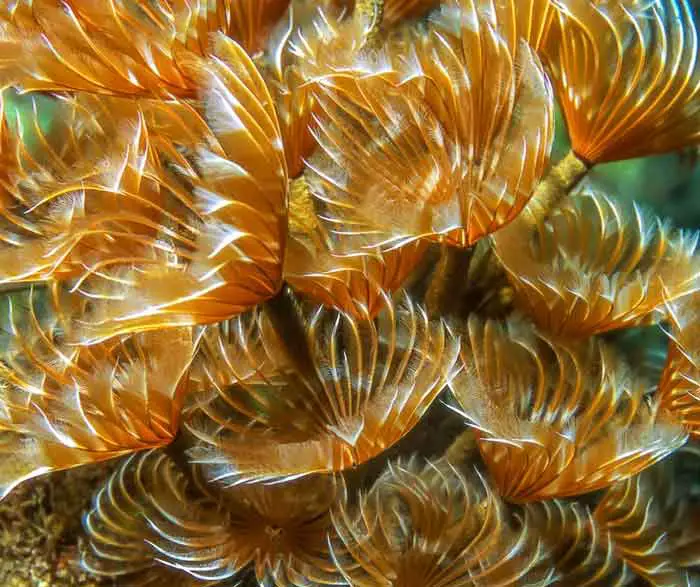
3) The invert was damaged and injured
If an annelid, like the feather duster worm, sustains significant damage to its body, that could be another cause of losing its feathers. This could, unfortunately, spiral out of control because once the feathers are shed, they won’t be able to feed—and therefore won’t be able to sustain enough energy from food to heal themselves.
4) It may be getting picked on (literally) by one of your fish
If you have a troublemaker in the tank that likes to nip at the feathers, like a six-line wrasse or flame angelfish that likes to nip, the stress from the constant nipping could cause the segmented fan worm to lose its feathers.
5) Starvation and malnourishment
Last, but not least, if your worm seemed healthy for a while then lost its feathers, the root cause might be malnutrition. These planktonic filter feeders need to be fed appropriately sized food routinely or they will slowly starve to death.
6) Constantly adjusting to changing aquarium conditions
While fan worms generally do hang out in one spot, they are not completely immobile. If the spot you placed your worm isn’t exactly where it wants to be, it is possible that it might decide to relocate itself to a different part of the tank. To do this, the worm actually leaves its tube, moves, and builds a new one. That might be reason enough to add one to your tank—just to see that :).
Feather duster worm compatibility
A feather duster worm won’t cause any compatibility issues in your tank—they are gentle creatures that will leave other animals alone (unless they are plankton, of course, because then they are food).
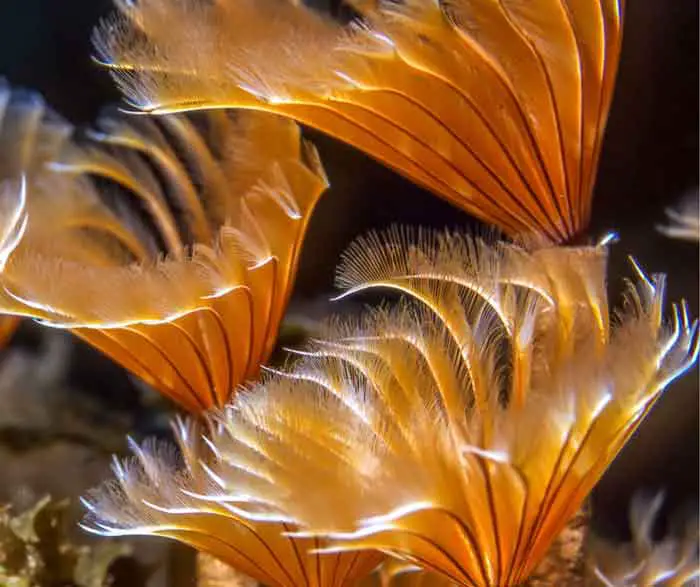
They don’t have stinging nematocysts like many corals and they won’t release chemicals to try and kill their neighbors like some corals will.
The biggest compatibility concern to think about is that segmented worms are the natural food of many other fishes and invertebrates. So you wouldn’t want to add them to a tank that has any animals likely to eat them. That basically rules out almost any fish or invertebrate that is not considered to be reef safe.
They also need to have their feather duster crowns extended in order to capture their food, so you don’t want to keep them with fishes that will find the feathers to be irresistible to nip at.
I think of curious nippers to generally come from the wrasse, butterfly, and angelfish families. If you have those species or hope to in the future, you might want to think twice or be cautious.
Also would recommend anything that has a predisposition to eating segmented worms–like the arrow crab, Melanurus wrasse, Six line wrasse, Longnose butterflyfish or Copperband butterflyfish.
Reproduction
Believe it or not, various species of fan worms are known to spawn in the aquarium, however, it is much less likely that larvae will settle in your tank and survive.
The worms that reproduce asexually will break off a piece of their body and send it off into the water to grow. This budding process happens naturally, and one worm can eventually form a colony of Sabellidaes. While this can become a problem over time, many feather dusters are slow to reproduce in captivity.
Do feather duster worms multiply in a reef tank?
It is possible for feather duster worms to multiply in a reef tank, but it is not very likely. Colony multiplication involves sexual reproduction or fragmentation, which is possible, but not very common in a reef tank.
Feeding
Since the feather duster worm is a substrate-attached filter feeder, it won’t be able to find its own meals, so you have to bring dinner to them, by adding direct dose feeding. They trap food floating by with its feathers and pull the food into its mouth, where it can be ingested and then digested.
The most popular foods for feather duster worms in a home aquarium are plankton and baby brine shrimp.
Feather duster worms for sale
These attractive annelids are frequently available at my local fish store. I’ve even seen them recently in a Petco.

You can also buy them online at most of the online stores.
Some species such as the Royal Featherduster are more expensive. If you are looking for a cheaper starter worm though then the Hawaiian Featherduster or the Dwarf Featherduster might be an excellent choice for your tank. Most aquarium shops will carry the most popular varieties of Sabellidaes like the Christmas Feather duster.
Whether to Buy a Featherduster Worm or Not
Feather duster worms are peaceful and won’t bother anything other than the food they eat. They don’t really have any other requirements than—reef tank water parameters, a light-to-moderate current, and the food they can eat. They can even be kept in small tanks. If you’re willing to meet those requirements and keep them away from animals that would eat them or torment them and you should have a happy and fascinating invertebrate that will captivate your houseguests.

You should read this next
Since the hardest part of caring for the feather duster worm is meeting their nutritional/feeding needs, here is some strongly recommended reading for you:
Not ready to move on yet? You can watch a short video on feather dusters:
If you’re looking for other interesting and unique invertebrates for your reef tank, check out:
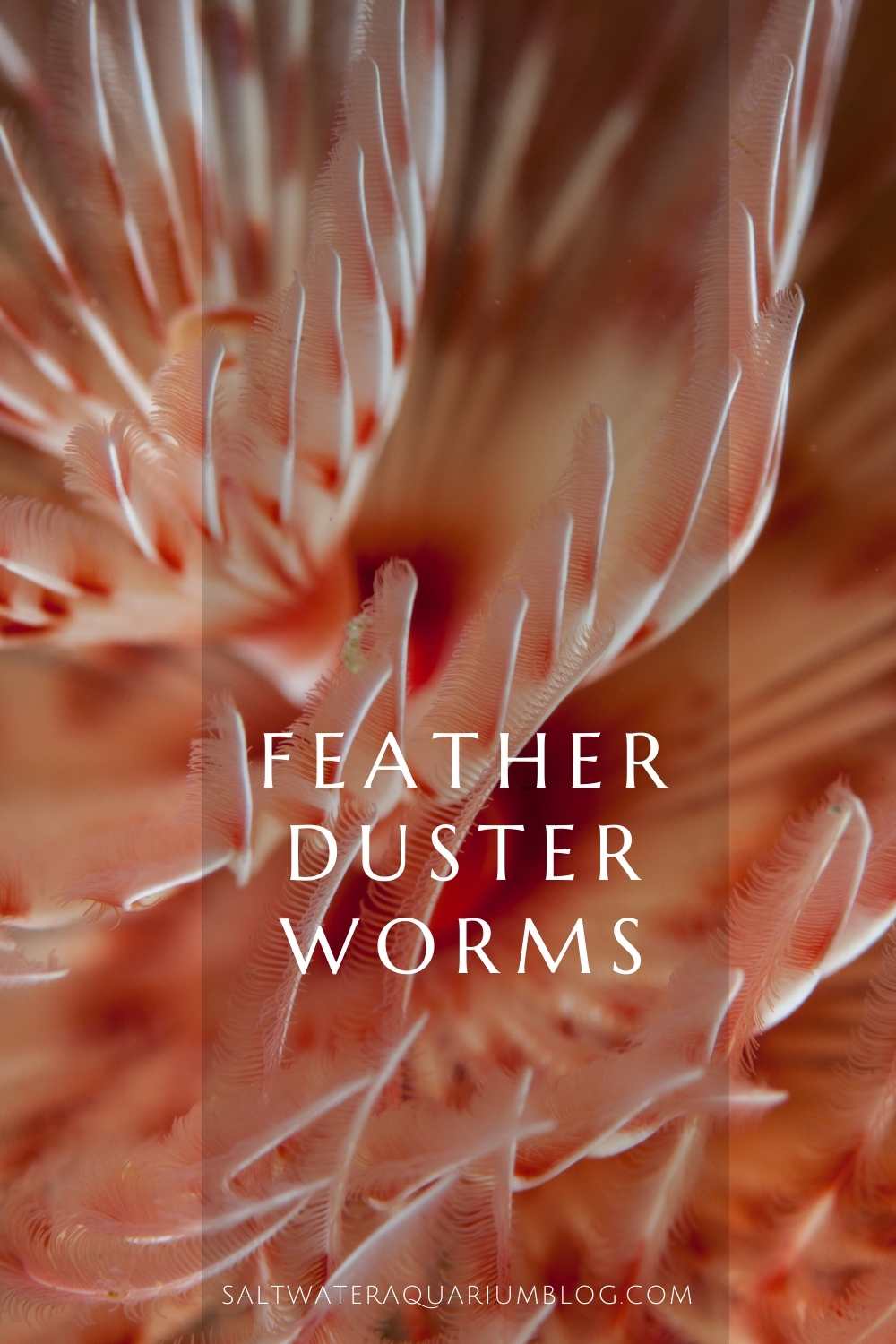

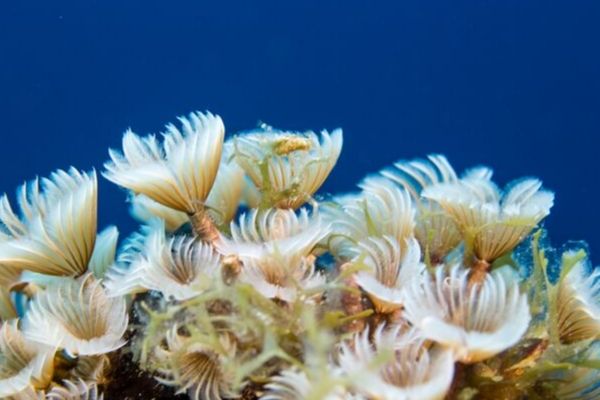

Leave a Reply